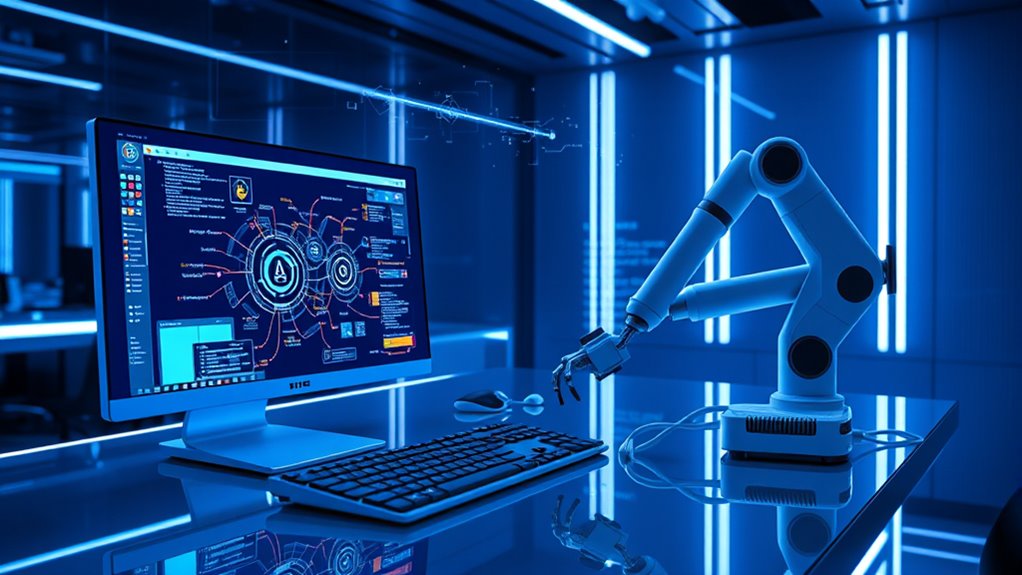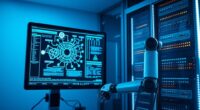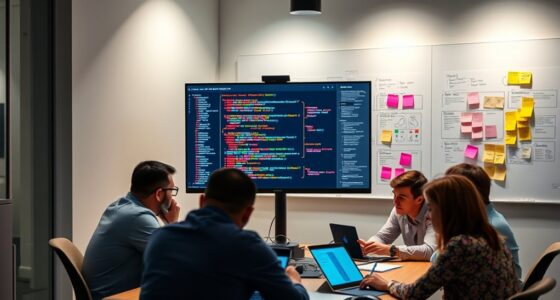AI-driven software design patterns use neural networks and pattern recognition to help you automate, optimize, and innovate your architecture choices. By analyzing large datasets, AI identifies recurring structures and suggests effective patterns like singleton or observer, speeding up development and reducing errors. It also assesses the performance and scalability of these patterns, guiding you toward more reliable solutions. Keep exploring further to discover how these advanced techniques can transform your software projects.
Key Takeaways
- AI analyzes codebases to identify and recommend effective design patterns like singleton or observer.
- Neural networks detect recurring structures, enabling automated pattern recognition across projects.
- AI evaluates pattern performance in real-world scenarios, guiding optimal architecture choices.
- Enhanced datasets and explainability improve AI’s accuracy in suggesting innovative, reliable design solutions.
- Integration of AI accelerates development, reduces errors, and fosters adaptive, maintainable software architectures.

Artificial intelligence is transforming how we develop software, especially when it comes to design patterns. With AI’s ability to analyze vast amounts of data, it’s now possible to automate and optimize the creation of software architectures. Neural networks, a subset of AI inspired by the human brain, play a pivotal role here. They excel at pattern recognition, enabling machines to identify complex relationships within data that might elude human programmers. When applied to software design, neural networks can analyze existing codebases, recognize recurring structures, and suggest the most effective design patterns for new projects. This process accelerates development, reduces errors, and leads to more efficient, maintainable code.
AI and neural networks revolutionize software design by recognizing patterns, optimizing architectures, and enhancing code efficiency and maintainability.
As you leverage AI-driven tools, you’ll find that pattern recognition becomes a powerful asset. Instead of manually sifting through countless lines of code to spot common solutions, AI can automatically detect these patterns and propose the best practices. For instance, if your project involves frequent use of singleton instances or observer relationships, AI algorithms can learn from previous implementations and recommend the most suitable pattern for your current context. This not only streamlines your workflow but also helps you adopt proven solutions more quickly. The ability to recognize patterns across diverse codebases means that AI can suggest innovative combinations or hybrid patterns that might not be immediately obvious, pushing the boundaries of traditional software design.
Furthermore, AI’s pattern recognition capabilities extend beyond simple identification. It can evaluate the efficiency of different design patterns in real-world scenarios, providing insights into performance, scalability, and robustness. This feedback loop allows you to refine your architecture continually, ensuring your software remains adaptable to changing requirements. As AI tools become more sophisticated, they can even predict potential issues before they manifest, guiding you toward more resilient design choices. This proactive approach minimizes bugs and technical debt, ultimately saving time and resources. Additionally, ongoing monitoring of AI behavior is essential to ensure these tools provide reliable guidance over time. Incorporating best practices in pattern recognition further enhances the accuracy and usefulness of AI-driven suggestions.
In addition, understanding the role of color accuracy and contrast ratio in visual representations can significantly influence how AI interprets and enhances software interfaces, making them more intuitive and user-friendly. Moreover, training AI models with diverse and comprehensive datasets can improve their ability to recognize complex design patterns, leading to even more innovative and effective solutions. As the industry advances, the integration of explainability in AI models can help developers better understand and trust AI recommendations, fostering a more collaborative human-AI development process. In essence, integrating AI into software design patterns transforms your approach from manual, trial-and-error methods to intelligent, data-driven decisions. Neural networks and pattern recognition enable you to craft architectures that are not only essential but also adaptable to evolving needs. By embracing these AI capabilities, you position yourself at the forefront of modern software development—creating more efficient, reliable, and innovative solutions with less effort and greater confidence.
Frequently Asked Questions
How Does AI Influence Traditional Design Pattern Selection?
You might wonder how AI influences traditional design pattern choices. AI accelerates algorithm optimization, enabling you to select patterns that better suit complex problems. It also enhances developer creativity by suggesting innovative solutions you may not have considered. Instead of rigidly following classic patterns, you adapt them with AI insights, making your software more efficient and adaptable. This dynamic approach helps you craft smarter, more responsive applications.
Can AI Replace Human Intuition in Software Design?
Like an oracle gazing into a crystal ball, you wonder if AI can replace human intuition in software design. While machine learning excels at pattern recognition, it lacks the nuanced judgment and creativity you bring. AI can assist by identifying trends and optimizing patterns, but it can’t fully replicate your instinct, experience, or understanding of complex, context-dependent problems. Your intuition remains essential in guiding innovative, adaptable software solutions.
What Ethical Considerations Arise With Ai-Driven Design?
When considering ethical issues, you need to address bias mitigation and transparency concerns. AI-driven design can unintentionally embed biases, so you must actively work to minimize these risks. Additionally, maintaining transparency about how AI makes decisions is vital for trust and accountability. You should guarantee clear communication about AI processes and regularly review algorithms to uphold fairness and ethical standards in your software development.
How Is AI Integrated Into Existing Software Development Workflows?
You might find that AI integration into your workflow begins with automated refactoring and code optimization, boosting efficiency. AI tools analyze your code to suggest improvements, catch bugs, and streamline processes. This seamless incorporation allows you to focus on complex problem-solving while AI handles repetitive tasks. As a result, your development becomes faster and more reliable, making AI an invaluable partner in modern software workflows.
What Are the Limitations of AI in Automating Design Patterns?
You might find that AI struggles with fully automating design patterns because it relies heavily on pattern recognition and automated code generation. While AI can identify common structures, it often falls short in understanding context, nuance, or unique project requirements. This means you can’t rely solely on AI for complex, creative design decisions, as it may miss subtle design principles or produce less optimized solutions, requiring human oversight.
Conclusion
You now see how AI-driven design patterns can revolutionize your software development. Embracing these tools helps you stay ahead of the curve and make smarter decisions faster. Remember, in this fast-paced tech world, you’ve got to keep your eyes on the prize. By integrating AI into your patterns, you’re not just keeping up—you’re setting the pace. So, don’t wait for the storm to pass; learn to dance in the rain and harness AI’s full potential.









